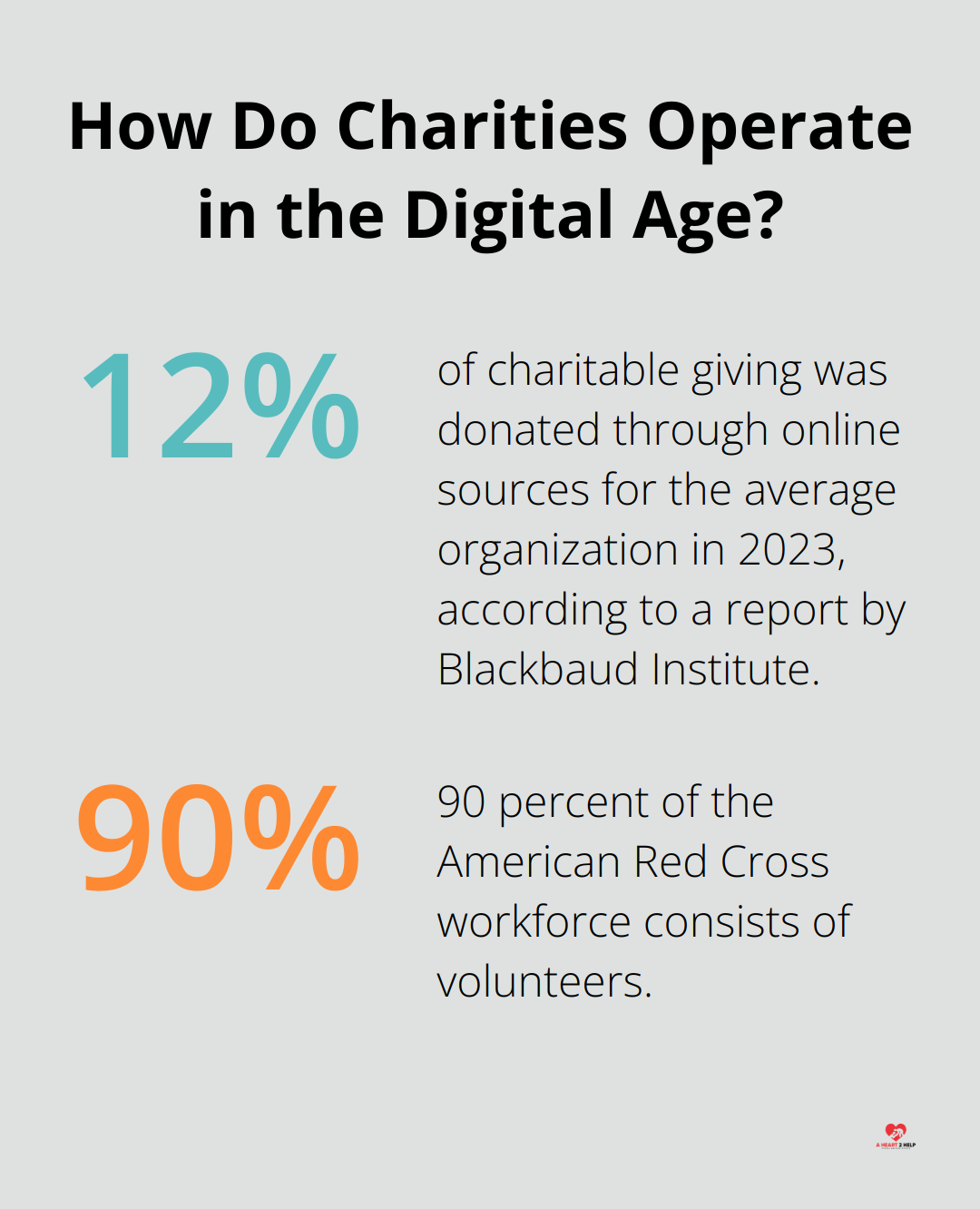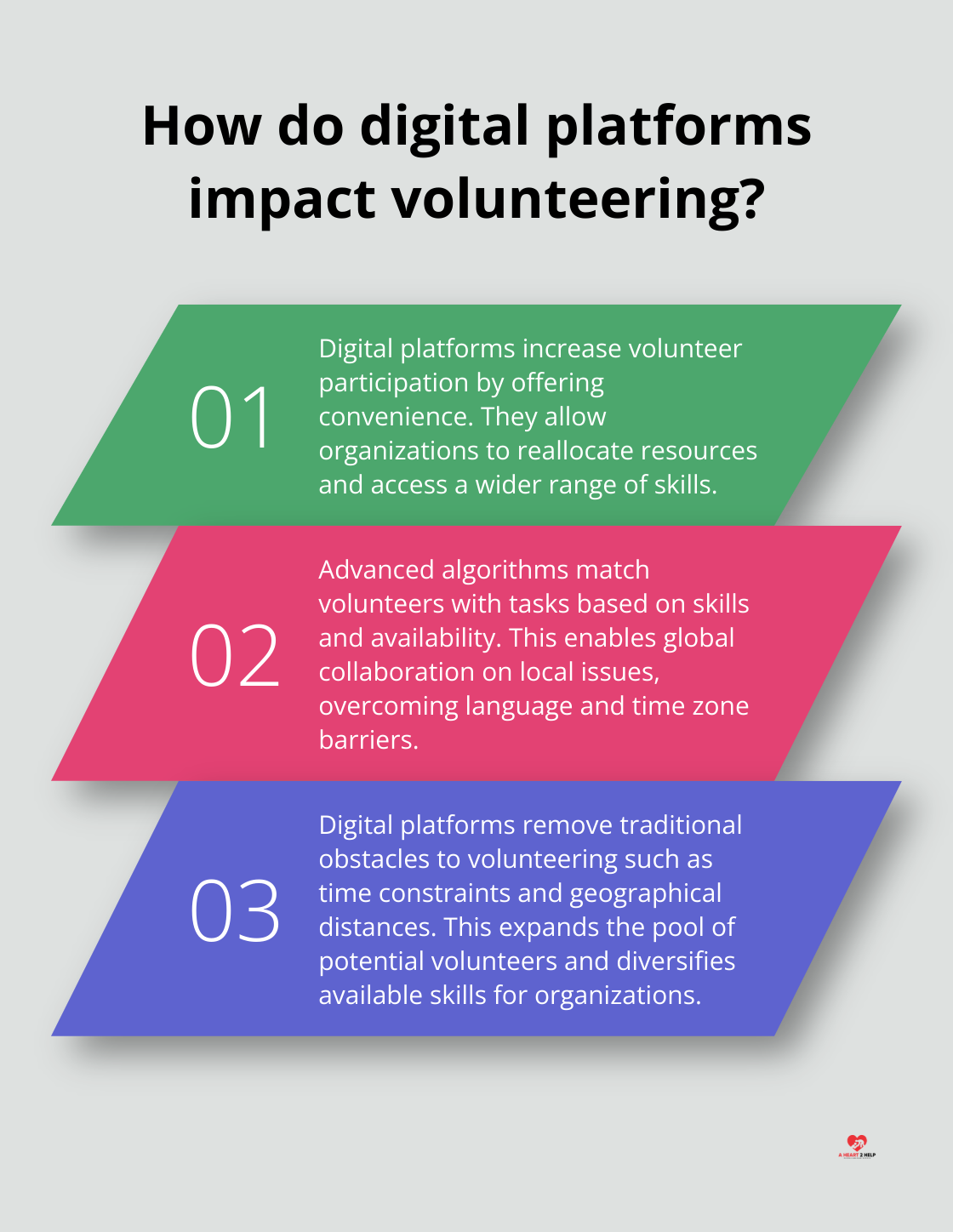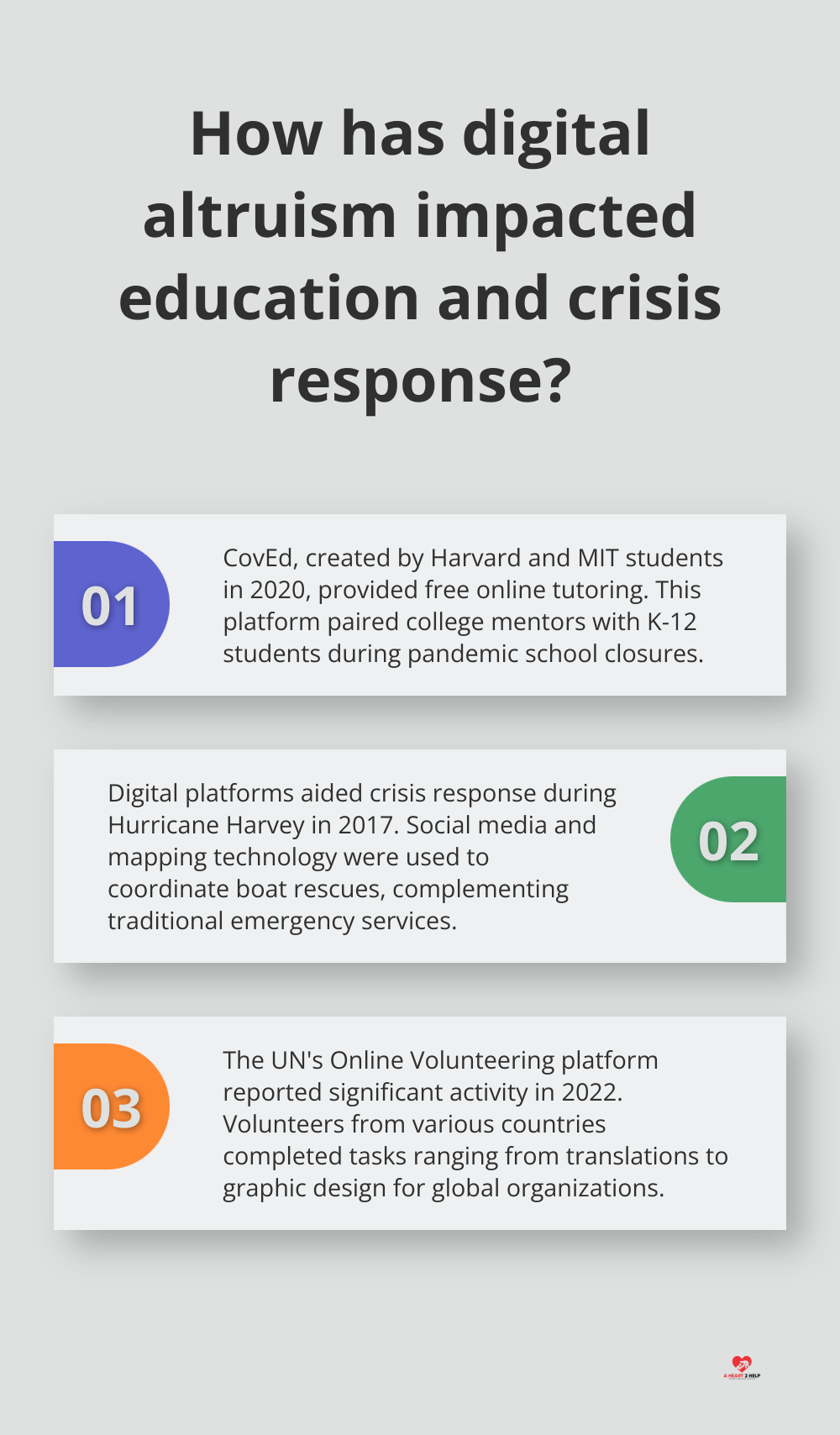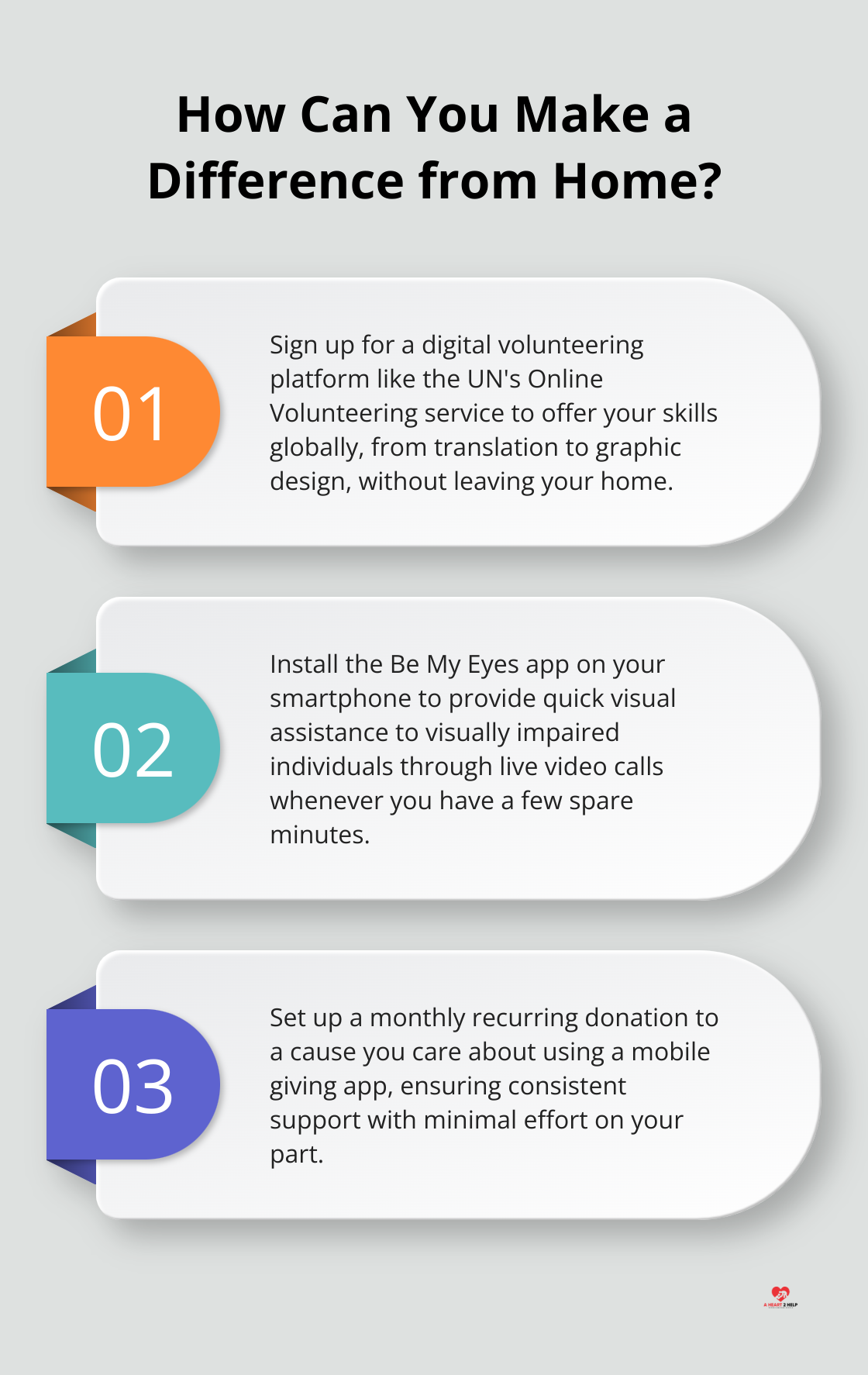Digital altruism is reshaping how we give back to our communities in 2025. At A Heart 2 Help, we’ve witnessed a surge in online platforms connecting volunteers with causes they’re passionate about.
Technology is breaking down barriers, making it easier than ever for people to contribute their time and skills from anywhere in the world. This shift is not only changing lives but also redefining the very nature of volunteering.
How Online Platforms Transform Volunteering
The landscape of volunteering undergoes a radical transformation in 2025, with online platforms at the forefront of this change. These digital hubs don’t just facilitate connections; they reshape the entire volunteering ecosystem.
A New Era of Opportunity
Nearly half of experts worry that changes in the ongoing evolution of digital life tied to the COVID-19 outbreak and societies’ responses to it may make digital life more challenging. This concern extends to the realm of online volunteering platforms, which have seen significant changes in recent years.
Breaking Down Barriers
One of the most significant impacts of these platforms is their ability to make volunteering accessible to a wider range of people. Individuals with mobility issues, those in remote areas, and people with busy schedules can now contribute meaningfully from their homes. A survey by InclusiveVolunteer.org found that 45% of online volunteers in 2025 had never participated in traditional volunteering before, citing accessibility as the primary reason for their engagement.
Redefining Traditional Models
While online platforms open new doors, they also challenge traditional volunteering models. Local organizations adapt by offering hybrid opportunities that combine in-person and virtual elements. The National Association of Volunteer Centers reports that 70% of their member organizations now offer some form of digital volunteering option (up from just 15% in 2020).

However, this shift isn’t without challenges. Some organizations struggle with volunteer retention in the digital space, finding it harder to build the same sense of community that in-person volunteering fosters. To address this, platforms innovate with virtual team-building activities and recognition programs to keep volunteers engaged and connected.
The Future of Volunteering
The future of volunteering isn’t just online or offline – it’s a dynamic blend of both. Technology leverages more opportunities for people to make a difference, regardless of their circumstances. As we move forward, organizations will need to strike a balance between digital convenience and meaningful impact.
This transformation in volunteering paves the way for more sophisticated methods of connecting volunteers with causes. In the next section, we’ll explore how AI-powered matching is revolutionizing the way people find and engage with volunteer opportunities.
How AI Revolutionizes Volunteer Matching
AI transforms the way volunteers connect with causes in 2025, creating a more efficient and impactful volunteering ecosystem. This technological leap addresses key challenges in the volunteering sector, such as volunteer retention and engagement.
Precision Matching for Maximum Impact
AI-driven platforms analyze vast amounts of data to create highly accurate matches between volunteers and opportunities. These systems consider factors like skills, interests, availability, and even personality traits to suggest the most suitable placements. Studies show that nonprofits leveraging AI for engagement experience a 40% increase in volunteer satisfaction compared to traditional methods.
Skill-Based Volunteering Takes Center Stage
The rise of AI matching leads to a surge in skill-based volunteering. Professionals now easily find opportunities that leverage their expertise, whether it’s in marketing, IT, or legal services. The volunteer management platforms market is projected to grow from $1.56 billion in 2024 to $1.86 billion in 2025, indicating a compound annual growth rate (CAGR) of 19.2%.
Real-Time Response to Community Needs
AI in volunteering responds to urgent community needs in real-time. During natural disasters or sudden crises, AI systems quickly mobilize volunteers with relevant skills and proximity to affected areas.
Predictive Analytics for Proactive Support
AI doesn’t just match current needs; it predicts future ones. Advanced algorithms analyze historical data and current trends to forecast upcoming community requirements. This proactive approach allows organizations to prepare volunteers and resources ahead of time, maximizing their impact when needs arise.
Personalized Volunteer Journeys
AI creates tailored volunteering experiences for each individual. It tracks a volunteer’s history, preferences, and impact, suggesting new opportunities that align with their evolving interests and skills. This personalization keeps volunteers engaged and motivated, leading to longer-term commitments and greater overall impact.

As AI continues to evolve, we can expect even more sophisticated matching capabilities. The future of volunteering isn’t just about connecting people with causes; it’s about creating the perfect synergy between skills, passion, and community needs. This technological revolution in volunteering paves the way for our next topic: the exciting world of gamification and social media in digital altruism.
How Gamification Transforms Digital Altruism
The Power of Virtual Rewards
Volunteer platforms in 2025 incorporate sophisticated reward systems that tap into our innate desire for achievement and recognition. The popular app VolunteerHero awards digital badges for completed tasks, hours logged, and skills acquired. These badges aren’t just for show – 60% of employers will use digital badges for recognizing soft skills and community engagement.

A study found that digital badges increase learner retention by 25% in job-focused courses. This gamification approach has proven particularly effective in engaging younger generations, with many volunteers citing achievement systems as a major motivator for their continued participation.
Social Media Integration Amplifies Impact
Social media integration amplifies the impact of individual actions. Platforms now allow volunteers to share their experiences and achievements directly to their social networks with a single tap. This feature not only celebrates individual contributions but also inspires others to get involved.
The ripple effect of social sharing is substantial. Data from VolunteerMatch shows that for every volunteering experience shared on social media, an average of 2.3 new volunteers are recruited. This viral spread of altruism has led to a 28% increase in overall volunteer participation since 2023.
Virtual Reality Revolutionizes Remote Volunteering
VR technology has emerged as a game-changer in digital altruism. VR now allows volunteers to immerse themselves in remote environments, providing a sense of presence and impact that was previously impossible.
Organizations offer experiences where volunteers can virtually visit schools they’ve helped build or see the direct impact of their donations on communities across the world. This technology has proven particularly impactful in disaster relief efforts, allowing volunteers to assist in coordination and planning without physically being in potentially dangerous areas.
Research has shown that VR can have significant effects on empathy, guilt, responsibility, and donation of time and money in social marketing contexts.
Competitive Altruism Drives Engagement
Gamification has introduced an element of friendly competition to digital altruism. Leaderboards and challenges (such as “Most Hours Volunteered” or “Highest Community Impact”) motivate volunteers to increase their contributions. This competitive aspect has proven especially effective in corporate volunteering programs, where teams compete to make the biggest difference.
A report from VolunteerMatch revealed that companies implementing gamified volunteering programs saw a 45% increase in employee participation rates compared to traditional programs.
Personalized Volunteering Journeys
Gamification elements allow for highly personalized volunteering experiences. Platforms now use AI to create custom “quests” or “missions” for volunteers based on their interests, skills, and past activities. This tailored approach keeps volunteers engaged and helps them develop new skills while making a meaningful impact.
Final Thoughts
Digital altruism reshapes volunteering and community engagement in 2025. Online platforms democratize access to opportunities, while AI-powered matching systems revolutionize how volunteers connect with causes. Gamification and social media integration transform volunteering into an engaging, social activity that inspires individuals to contribute more.

These trends fundamentally alter how communities address challenges. We observe increased participation from diverse groups, more efficient resource allocation, and a greater sense of global community. As virtual and physical worlds merge, the concept of “community” expands, fostering global citizenship and shared responsibility.
A Heart 2 Help stands at the forefront of this digital altruism revolution. Our care-app connects compassionate individuals with those in need, promoting community support. We harness technology to make volunteering accessible and impactful, ensuring help is available when and where it’s needed most.
